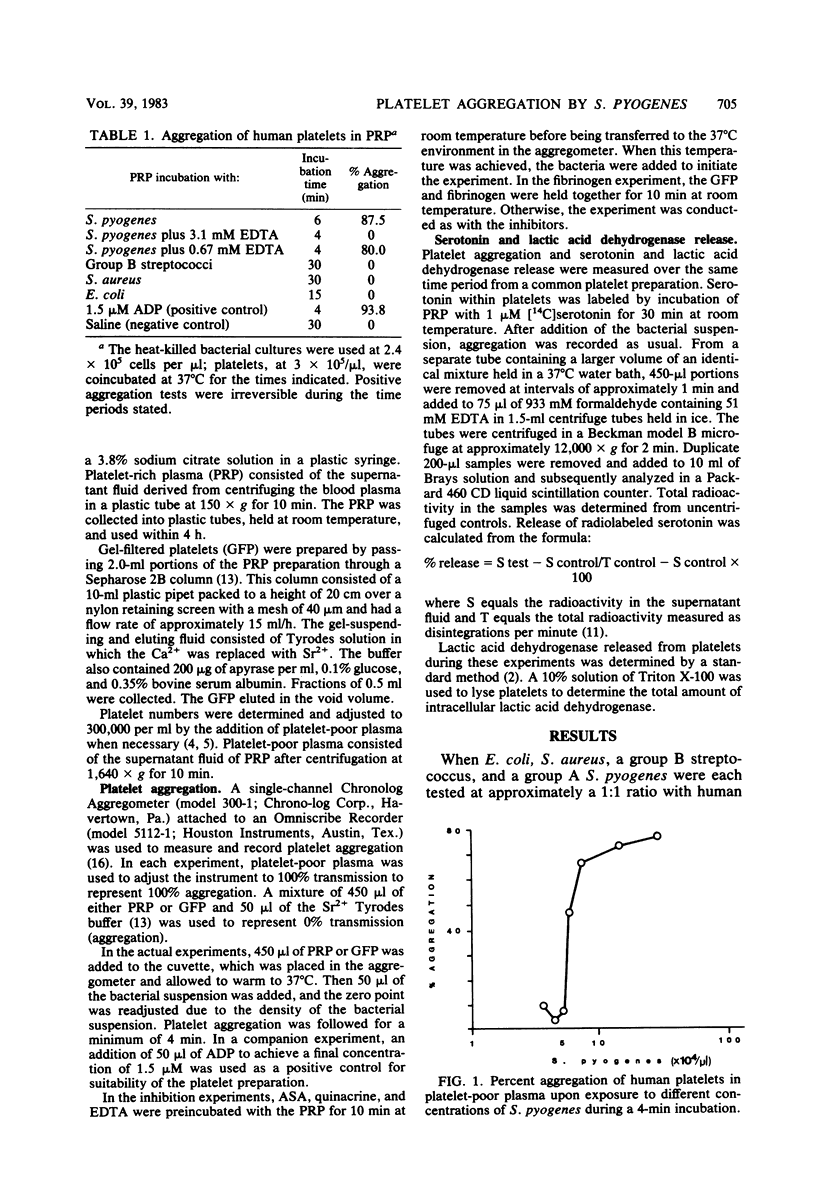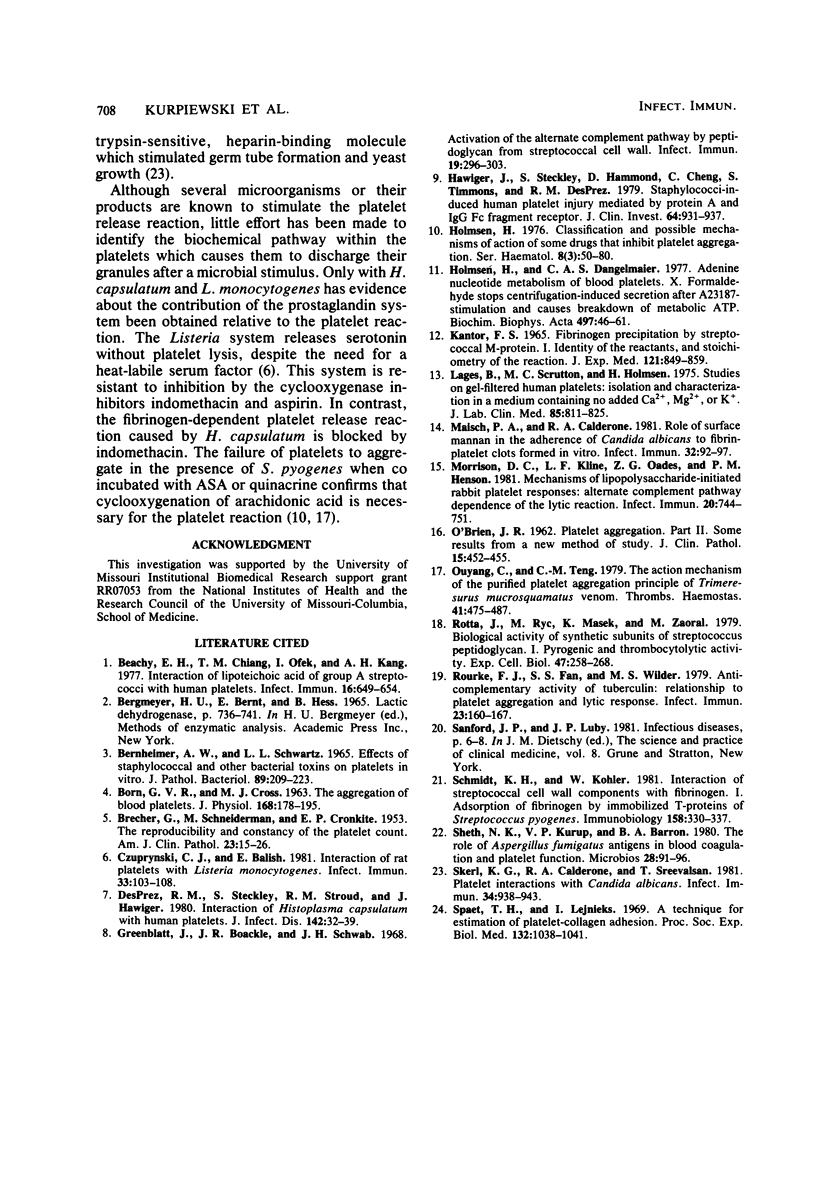Abstract
Heat-killed group A Streptococcus pyogenes induced platelet aggregation in platelet-rich plasma. Aggregation was dependent upon the ratio of platelets to bacteria, with maximal aggregation occurring at 0.8 platelets per bacterium (final concentration, 300,000 per microliter). Inhibition of the reaction by 3 mM EDTA indicated it was a true aggregation and not merely adhesion and agglutination. Lactic acid dehydrogenase assays indicated lysis of platelets did not occur during a 6-min incubation period. Aggregation was inhibited in a dose-dependent manner by acetylsalicylic acid (100 microM to 10 mM) and quinacrine (15.6 to 250 microM), with no decrease in aggregation at the lowest concentration of inhibitor tested. S. pyogenes induced the release of [14C]serotonin, which was maximal (50%) at 2.4 min, when aggregation was nearly complete. Gel-filtered platelets were not aggregated unless fibrinogen (final concentration, 1.8 mg/ml) was included in the reaction mixture. Staphylococcus aureus, a group B streptococcus, and Escherichia coli were unable to induce aggregation in platelet-rich plasma under the conditions used for S. pyogenes.
Full text
PDF




Selected References
These references are in PubMed. This may not be the complete list of references from this article.
- BERNHEIMER A. W., SCHWARTZ L. L. EFFECT OF STAPHYLOCOCCAL AND OTHER BACTERIAL TOXINS ON PLATELETS IN VITRO. J Pathol Bacteriol. 1965 Jan;89:209–223. doi: 10.1002/path.1700890121. [DOI] [PubMed] [Google Scholar]
- BORN G. V., CROSS M. J. THE AGGREGATION OF BLOOD PLATELETS. J Physiol. 1963 Aug;168:178–195. doi: 10.1113/jphysiol.1963.sp007185. [DOI] [PMC free article] [PubMed] [Google Scholar]
- BRECHER G., SCHNEIDERMAN M., CRONKITE E. P. The reproducibility and constancy of the platelet count. Am J Clin Pathol. 1953 Jan;23(1):15–26. doi: 10.1093/ajcp/23.1.15. [DOI] [PubMed] [Google Scholar]
- Beachey E. H., Chiang T. M., Ofek I., Kang A. H. Interaction of lipoteichoic acid of group A streptococci with human platelets. Infect Immun. 1977 May;16(2):649–654. doi: 10.1128/iai.16.2.649-654.1977. [DOI] [PMC free article] [PubMed] [Google Scholar]
- Czuprynski C. J., Balish E. Interaction of rat platelets with Listeria monocytogenes. Infect Immun. 1981 Jul;33(1):103–108. doi: 10.1128/iai.33.1.103-108.1981. [DOI] [PMC free article] [PubMed] [Google Scholar]
- Des Prez R. M., Steckley S., Stroud R. M., Hawiger J. Interaction of Histoplasma capsulatum with human platelets. J Infect Dis. 1980 Jul;142(1):32–39. doi: 10.1093/infdis/142.1.32. [DOI] [PubMed] [Google Scholar]
- Greenblatt J., Boackle R. J., Schwab J. H. Activation of the alternate complement pathway by peptidoglycan from streptococcal cell wall. Infect Immun. 1978 Jan;19(1):296–303. doi: 10.1128/iai.19.1.296-303.1978. [DOI] [PMC free article] [PubMed] [Google Scholar]
- Hawiger J., Steckley S., Hammond D., Cheng C., Timmons S., Glick A. D., Des Prez R. M. Staphylococci-induced human platelet injury mediated by protein A and immunoglobulin G Fc fragment receptor. J Clin Invest. 1979 Oct;64(4):931–937. doi: 10.1172/JCI109559. [DOI] [PMC free article] [PubMed] [Google Scholar]
- Holmsen H. Classification and possible mechanisms of action of some drugs that inhibit platelet aggregation. Ser Haematol. 1975;8(3):50–80. [PubMed] [Google Scholar]
- Holmsen H., Setkowsky Dangelmaier C. A. Adenine nucleotide metabolism of blood platelets. X. Formaldehyde stops centrifugation-induced secretion after A23187-stimulation and causes breakdown of metabolic ATP. Biochim Biophys Acta. 1977 Mar 29;497(1):46–61. doi: 10.1016/0304-4165(77)90138-6. [DOI] [PubMed] [Google Scholar]
- KANTOR F. S. FIBRINOGEN PRECIPITATION BY STREPTOCOCCAL M PROTEIN. I. IDENTITY OF THE REACTANTS, AND STOICHIOMETRY OF THE REACTION. J Exp Med. 1965 May 1;121:849–859. doi: 10.1084/jem.121.5.849. [DOI] [PMC free article] [PubMed] [Google Scholar]
- Lages B., Scrutton M. C., Holmsen H. Studies on gel-filtered human platelets: isolation and characterization in a medium containing no added Ca2+, Mg2+, or K+. J Lab Clin Med. 1975 May;85(5):811–825. [PubMed] [Google Scholar]
- Maisch P. A., Calderone R. A. Role of surface mannan in the adherence of Candida albicans to fibrin-platelet clots formed in vitro. Infect Immun. 1981 Apr;32(1):92–97. doi: 10.1128/iai.32.1.92-97.1981. [DOI] [PMC free article] [PubMed] [Google Scholar]
- Morrison D. C., Kline L. F., Oades Z. G., Henson P. M. Mechanisms of lipopolysaccharide-initiated rabbit platelet responses: alternative complement pathway dependence of the lytic response. Infect Immun. 1978 Jun;20(3):744–751. doi: 10.1128/iai.20.3.744-751.1978. [DOI] [PMC free article] [PubMed] [Google Scholar]
- O'brien J. R. Platelet aggregation: Part I Some effects of the adenosine phosphates, thrombin, and cocaine upon platelet adhesiveness. J Clin Pathol. 1962 Sep;15(5):446–452. doi: 10.1136/jcp.15.5.446. [DOI] [PMC free article] [PubMed] [Google Scholar]
- Ouyang C., Teng C. M. The action mechanism of the purified platelet aggregation principle of Trimeresurus mucrosquamatus venom. Thromb Haemost. 1979 May 25;41(3):475–490. [PubMed] [Google Scholar]
- Rotta J., Rýc M., Masek K., Zaoral M. Biological activity of synthetic subunits of streptococcus peptidoglycan. I. Pyrogenic and thrombocytolytic activity. Exp Cell Biol. 1979;47(4):258–268. doi: 10.1159/000162944. [DOI] [PubMed] [Google Scholar]
- Rourke F. J., Fan S. S., Wilder M. S. Anticomplementary activity of tuberculin: relationship to platelet aggregation and lytic response. Infect Immun. 1979 Jan;23(1):160–167. doi: 10.1128/iai.23.1.160-167.1979. [DOI] [PMC free article] [PubMed] [Google Scholar]
- Schmidt K. H., Köhler W. Interaction of streptococcal cell wall components with fibrinogen. I. adsorption of fibrinogen by immobilized T-proteins of streptococcus pyogenes. Immunobiology. 1981;158(4):330–337. doi: 10.1016/S0171-2985(81)80004-6. [DOI] [PubMed] [Google Scholar]
- Sheth N. K., Kurup V. P., Barron B. A. The role of Aspergillus fumigatus antigens in blood coagulation and platelet function. Microbios. 1980;28(112):91–96. [PubMed] [Google Scholar]
- Skerl K. G., Calderone R. A., Sreevalsan T. Platelet interactions with Candida albicans. Infect Immun. 1981 Dec;34(3):938–943. doi: 10.1128/iai.34.3.938-943.1981. [DOI] [PMC free article] [PubMed] [Google Scholar]
- Spaet T. H., Lejnieks I. A technique for estimation of platelet-collagen adhesion. Proc Soc Exp Biol Med. 1969 Dec;132(3):1038–1041. doi: 10.3181/00379727-132-34362. [DOI] [PubMed] [Google Scholar]


